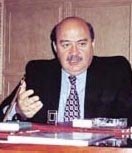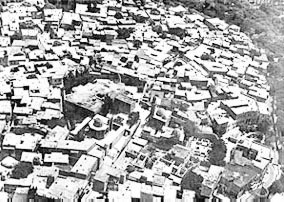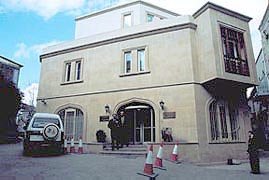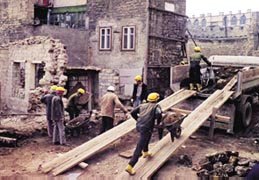|
Winter
1998 (6.4) Interview with
Elbey Gasimzade
Left: British Petroleum's new office building in the Inner City which now houses both BP and Amoco after their merger became official on December 31, 1998. Right: Contemporary construction going on in Baku's "Inner City". During the Soviet period, urban planners tried to develop "satellite cities" like Sumgayit, 30-60 kilometers away from Baku. This is not a great distance, but the fact that people had to be moved from their native environment was very unsettling. It was a great psychological shock to them. Such plans resembled fascist ideology. At the time, it was easier to relocate people because the government could provide new accommodations for them. Plus, they were forced to move. Today, legal relationships have changed, and it is not such an easy task to relocate people. Nor is there any guarantee that an apartment will be found. Furthermore, most people now own their apartments and are reluctant to leave. Is there a Master Plan for Baku? Yes, this plan was begun in 1963 and completed in 1971. At the time, the USSR Construction Committee thought that the plan had a lot of mistakes. Unfortunately, it took 12 years for the State Project Institute to update the plan. Eventually, it was completed and delivered to us in 1984. The first Master Plan for Baku was designed in 1924. Actually, Baku was the first city in the USSR to have a Master Plan. After that, a master plan was introduced four times. The last one was to have been carried out by 2005. But in 1991, the political situation changed completely, and the plan soon became obsolete. Without a master plan in place, Baku's development proceeds in an unorganized fashion. Right now, each builder acts according to his own ideas and needs-a situation that is likely to create major problems for the future. We need to work out Baku's revised Master Plan as soon as possible. What's happening with the "Inner City"? Some years ago, a master plan was drawn up for Baku's "Inner City" (Ichari Shahar) which basically called for the preservation of only 50 houses and the demolition of the rest. Today, some people say that the Inner City should not be touched. But that's ridiculous. The Inner City has been developing for centuries. Why could someone build there in the 11th century, the 17th century or the 19th century, but not be able to do so in the 20th century? I am not against having modern buildings in Ichari Shahar. Why should we have to copy 14th- and 17th-century designs? I am often asked why we construct new buildings and allow oil companies to build their offices there. Let's keep in mind that Ichari Shahar was not built in a few days. It has developed over 14 centuries. Most of the residences that we see today were built 100, 120 or hardly 150 years ago. If someone owns a building in Ichari Shahar, why should he be forced to keep it the way his father had it? Ichari Shahar is a dynamic place. We call it "shahar", which means "town", because people live and do business there. Otherwise, it would become "Olu Shahar" meaning "dead town". The companies that have built offices in Ichari Shahar have put a great deal of investment into their projects. BP-Statoil's office (now BP / Amoco), built in the center of Ichari Shahar, is a good example. I was the architect of that design. Before its renovation, the place was in ruins. When these companies leave Baku, they're not going to take the building with them to Great Britain. The office will be sold either to a local or a foreign company. Ramco has also carried out the renovation of one of our historic buildings very successfully in the Inner City. How do refugees figure into these planning issues? Many of the refugees come to me and ask for a small piece of land. They say they cannot live in a nine-story building. They want to breed sheep and cattle. That's why they lease land in Garadagh about 40 minutes away from Baku. Everyday they get up very early and go out there and graze their animals and then return late in the evening. In my opinion, building houses for refugees in Baku is not the right approach. We still hope that someday they will be able to go back to their lands. However under the initiative of Baku mayor Rafael Allahverdiyev, we are in the process of constructing about 300 temporary shelters for refugees in the Bilasuvar region, a region close to the Iranian border. What role does foreign investment play in Azerbaijan's development? We know that we need to attract as many investors as possible to Baku for its development. Presently, we do not have the money to carry out large-scale projects on our own. We manage to complete minor works that are needed for the city, but we invite investors to undertake large-scale constructions. I am sometimes asked why we let foreigners construct buildings here. But this is narrow-minded. Foreigners have the opportunity to do so. Should we wait 50 years until we are able to do it? Whether we want to or not, we need to agree to their conditions and suggestions. For example, if an investor says that he wants to build an apartment complex, we can't tell him to build a kindergarten. He first needs to cover his costs and after that maybe he will invest in a kindergarten. Our president attaches great significance to attracting foreign investment to Azerbaijan. This is one of the main directions of the industrial and political policy of our government today. And it is quite right. Like every young developing country, Azerbaijan needs help from others. How do foreign investors get their projects approved? First, an investor appeals to the Baku Mayor, states his purpose and indicates the resources he wants to invest and the purpose of construction. Then the Mayor's Office selects an appropriate site. If the site is a place where others are living, the investor will need to purchase the houses or apartments from the residents themselves. In this case, none of the money goes to the Mayor's Office. If the site is vacant, 30 percent of the income from the project will go to the Mayor's Office. Then the developer prepares a preliminary design and presents it to the Baku Urban Planning Department. Once the project is approved, it would be developed and a building permit would be obtained through the Building Department. Recently the Law of the Azerbaijan Republic on Architecture Activity was adopted. According to this law, any architect carrying out activity in Azerbaijan must have a license (irrespective of nationality), and any foreign architect needs to carry out activities along with a local architect (on an equal basis). Baku has its own unique architectural characteristics, and it is important to preserve them. Each potential building project is discussed with the 13-member City Building Council. Azerbaijan's most prominent architects serve on the Council, including Tal'at Khanlarov, Nazim Hajibeyov and Ilham Aliyev. These members look at the projects at hand and express their opinions about them. Then suggestions for modifications are made. As for aesthetics, I would say that each architect has his own design concepts. What do you think Baku will look like 10-15 years from now? I am often asked what I imagine the future of Baku will be like. I hope the construction process that started four or five years ago will continue. The new Master Plan should designate the location of buildings, but the design of the buildings should be left open. An architect should have the chance to express his own talent and unless the project is inferior from a design point-of-view, there should not be any interference. Of course, other architects will hold this post of the city's Chief Architect after me, and the future appearance of the city depends on them. I do have one request of the architects who will lead the architecture of Baku into the future, and that is that they not lose the specific spirit of Baku, not spoil the proportion of its streets and not destroy these city blocks that we love so much.  Why did you become an architect? I grew up surrounded by architecture. My father was an architect-he worked as a professor, member of the Academy, Minister, Vice-Prime Minister and Rector of the Polytechnical Institute. He was also the architect for buildings on Husi Hajiyev Street, Ulduz Metro station in Baku, as well as buildings in other towns in Azerbaijan. Many of our family friends were architects. Until I reached 16, I had always wanted to become a diplomat. My father directed my attention to architecture. Today when I look up and see these grand buildings in Baku, I'm so pleased that I became an architect. For me, it was the right decision. Elbey Gasimzade
is the son of famous Azerbaijani architect Anvar Gasimzade. He
has held the position of Baku's Chief City Architect operating
out of the Mayor's office for the past nine years. He also currently
serves as Vice-President of the Union of Architects of Azerbaijan.
Back to Index
AI 6.4 (Winter 1998) |



